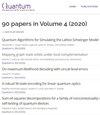高温量子Ising模型的经典模拟
IF 5.1
2区 物理与天体物理
Q1 PHYSICS, MULTIDISCIPLINARY
引用次数: 0
摘要
我们考虑了广义量子Ising模型,包括那些可以描述无序材料或量子退火炉的模型,并且我们证明了对于所有高于系统大小独立阈值的温度,基于世界线热槽更新的路径积分蒙特卡罗方法总是混合到平稳时间$\mathcal{O}(n \log n)$对于$n$量子比特系统,因此提供了配分函数的完全多项式时间近似方案。当温度大于所有量子位的最大相互作用程度(价)的四加两倍时,这个结果就成立,以局部耦合强度为单位测量。例如,这意味着在800 mK以上的温度下,超导器件热态的经典模拟建模是一个最大价为6、耦合强度为1 GHz的受挫量子Ising模型,总是可能的。尽管量子系统处于高温,但由量子到经典映射产生的经典自旋系统包含强耦合,这导致单点Glauber动力学混合缓慢。因此,此结果取决于worldline更新的使用(worldline更新是一种可以有效实现的集群更新形式)。这一结果对基于量子Ising模型平衡态的各种NISQ器件在模拟量子模拟中获得量子优势所需的温度有明确的限制。本文章由计算机程序翻译,如有差异,请以英文原文为准。
Classical Simulation of High Temperature Quantum Ising Models
We consider generalized quantum Ising models, including those which could describe disordered materials or quantum annealers, and we prove that for all temperatures above a system-size independent threshold the path integral Monte Carlo method based on worldline heat-bath updates always mixes to stationarity in time $\mathcal{O}(n \log n)$ for an $n$ qubit system, and therefore provides a fully polynomial-time approximation scheme for the partition function. This result holds whenever the temperature is greater than four plus twice the maximum interaction degree (valence) over all qubits, measured in units of the local coupling strength. For example, this implies that the classical simulation of the thermal state of a superconducting device modeling a frustrated quantum Ising model with maximum valence of 6 and coupling strengths of 1 GHz is always possible at temperatures above 800 mK. Despite the quantum system being at high temperature, the classical spin system resulting from the quantum-to-classical mapping contains strong couplings which cause the single-site Glauber dynamics to mix slowly, therefore this result depends on the use of worldline updates (which are a form of cluster updates that can be implemented efficiently). This result places definite constraints on the temperatures required for a quantum advantage in analog quantum simulation with various NISQ devices based on equilibrium states of quantum Ising models.
求助全文
通过发布文献求助,成功后即可免费获取论文全文。
去求助
来源期刊

Quantum
Physics and Astronomy-Physics and Astronomy (miscellaneous)
CiteScore
9.20
自引率
10.90%
发文量
241
审稿时长
16 weeks
期刊介绍:
Quantum is an open-access peer-reviewed journal for quantum science and related fields. Quantum is non-profit and community-run: an effort by researchers and for researchers to make science more open and publishing more transparent and efficient.
 求助内容:
求助内容: 应助结果提醒方式:
应助结果提醒方式:


